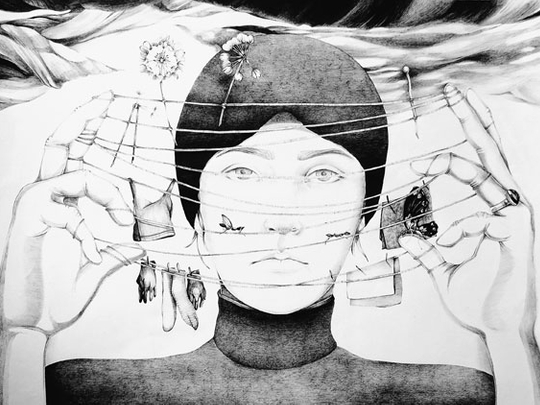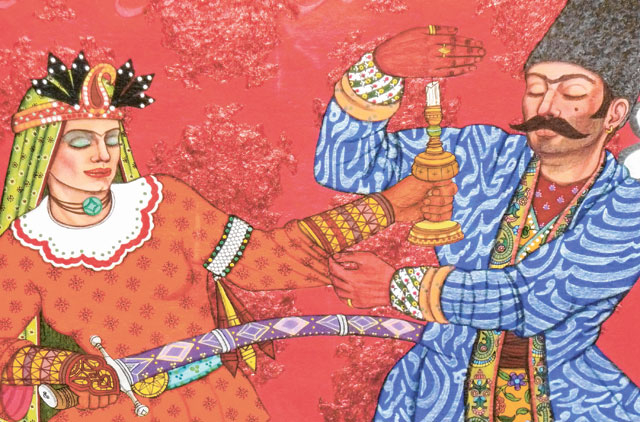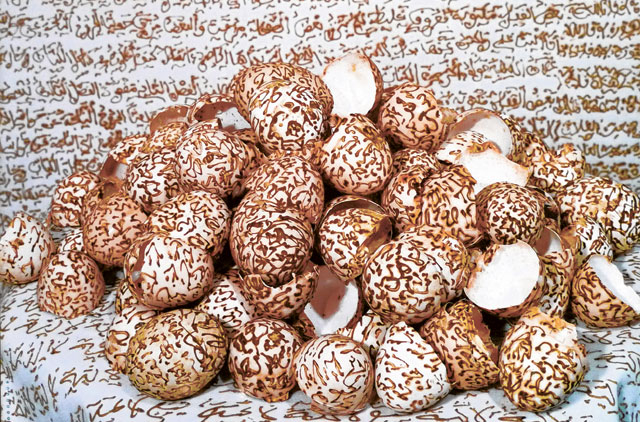
There are many artists in this region who are pushing the boundaries of contemporary Arab and Iranian art through a unique vocabulary that combines local artistic traditions and modern Western practices. An exhibition titled The Dreamer and the Poet brings together five such artists from Tunisia, Morocco, Iran and Egypt. The artworks on display offer insight into the lives and the viewpoints of the individual artists and tell stories about their world in a language that is universal.
The dreamer in the title of this show refers to Asal Falah. The young Iranian artist takes viewers into the world of her dreams and imagination through the haunting, metaphysical drawings from her My World series. Her detailed drawings, done with a black pen on a white board, are filled with traditional Iranian symbols, such as birds, flowers, insects, fish, snakes, butterflies emerging from cocoons and people bound by strings. They reveal her fears, aspirations and thoughts regarding relationships, personal freedom and other issues.
"My aim with this collection was to create a visual autobiography in an environment that travels from life's realities to an imaginary world. I have been working on this series for ten years, and it has been quite a therapeutic process, because I have honestly expressed my feelings about everything that concerns me in real life. My simple palette provides a sense of tranquillity, allowing me to express my sorrows and loneliness in a virtual space that connects me with my viewers and helps fill the emptiness in my life," Falah says.
"I believe that escaping from reality through art can be a constructive and positive force that can heal and provide a sense of freedom. And I hope that my work will enable my viewers too to escape from the harsh realities of their lives and fly with me to an inner world of unlimited dreams," she adds.
The poet in this show is Abdullah Akar. The Tunisian calligrapher moved to Paris in the late 1960s, and his work is inspired by Arabic and Western poetry. Akar is known for his experiments with diverse art forms and materials such as textiles, wood and iron. His work in this show combines the poems of Kahlil Gibran and Mahmoud Darwish with flourishes of bright colours and interesting textures to offer a contemporary take on traditional calligraphy.
"My work demonstrates that while being faithful to tradition, an artist can also be fearless in incorporating new trends. I have incorporated graffiti, sculpture and photography in my paintings because I want to present a traditional art form with a modern context and vision. I want to debunk the myth that the ancient art of Arabic calligraphy is a fossilised craft. My work leads viewers from the old to the new, from the distant past to the present, proving that this art form remains traditional but ‘alive'," Akar says.
Moroccan artist Lalla Essaydi's work also offers an interesting new twist on tradition. Her photographic series, The Night of the Henna, is inspired by traditional Moroccan wedding customs and Arabic calligraphy. The title refers to the elaborate "women only" ceremony on the eve of the marriage, when the bride's hands and feet are adorned with intricate henna patterns. The pictures, however, do not feature any brides. Essaydi has instead used objects that are customary wedding gifts, such as flowers, eggs, candles and sugar, to represent the bride.
Essaydi's photographs feature piles of eggshells, floral bouquets, lumps of sugar and burning candles — all covered with henna patterns. The images of these stark white objects decorated with henna are beautiful and thought-provoking. Although the artist remains behind the camera, these photographs present an intimate portrait of her. In fact, the henna patterns are actually excerpts from the artist's personal journal, documenting her experiences and expressing her thoughts on conventional distinctions between women and men, public and private, past and present, self and other, and memory and imagination.
"Traditionally, henna designs are applied by and on women during significant rites of passage and times of celebration. And calligraphy was traditionally taught only to men. By writing with henna, I am embracing my cultural heritage and its gender roles. Yet, as a self-taught calligrapher I am also exercising my freedom here. These contradictions in my work are deliberate because I want to break stereotypes and present myself through multiple lenses — as an artist, an Arab, an African, a traditionalist, a liberal and a Muslim," she says.
Iranian artist Hussain Fasih's colourful and detailed illustrations of 13th-century Persian poetry, and Egyptian artist Amr Fekry's meditative black-and-white photographs from his Whirling Dervishes collection, are also part of this interesting mosaic of contemporary Arab and Iranian art.
Jyoti Kalsi is an art enthusiast based in Dubai.
The Dreamer and the Poet will run at Pro Art Gallery's new space in Sunset Mall on Jumeirah Beach Road until January 20.













